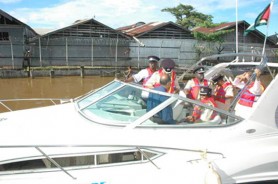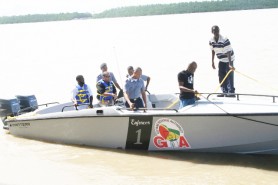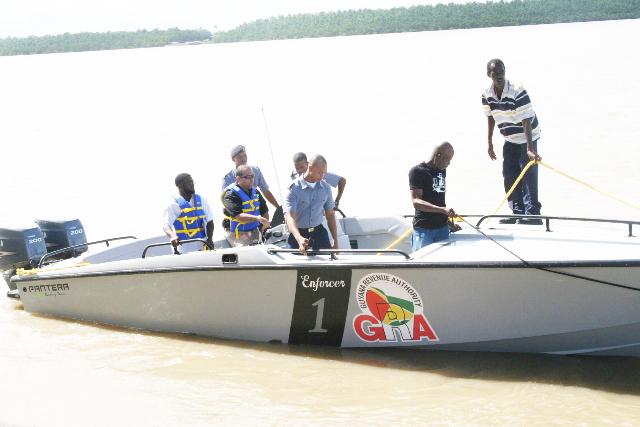Is the war against piracy along Guyana’s wild coast being won?
Maritime piracy in Guyana is a by-product of the well-known water-borne coastal crimes –backtracking, contraband trade, drug-smuggling, fuel-smuggling and gun-running. The Guyana Police Force and the Defence Force Coast Guard over the past decade or so have been unable to eliminate the scourge mainly because they do not possess sufficient resources to identify the culprits and to conduct continuous patrols.
The economic reality is that the fishing sector employs over 14, 000 fishermen and fish farmers and a further 5,800 in processing and marketing. Another 15,000 depend directly on fisheries and many more benefit indirectly from fishing-related occupations such as boat-building, accessories supply and maintenance services.

The security reality is that, although the Police Force is deployed in all six coastal regions – from the Barima-Waini to the East Berbice-Corentyne – it is gravely deficient in manpower. The Force has no substantial maritime establishment with sufficient vessels and skilled personnel to conduct maritime patrols by day and night along the coastland and in the estuaries of the numerous creeks and rivers.
It was only last month that Minister of Home Affairs Minister Clement Rohee handed over a refurbished $16.9M fibreglass boat to Police Commissioner Henry Greene to boost the Force’s maritime crime-fighting capabilities. Mr Rohee said at the time that the Government thought it “prudent” to build the capacity of the maritime division “especially in light of the recent spate of piracy and crimes committed using water as a means of escape.”
The international reality has been that, several years ago, the International Chamber of Shipping had designated Georgetown as one of the ports in which masters and security officers of ships should exercise special caution when entering, given the high rates of piracy. According to the Chamber, many ships, especially foreign ones, had become victims of ‘pirate’ attacks, mostly constituting non-violent theft, when entering the Georgetown harbour.
The Stabroek News reported that, in conjunction with the International Shipping Federation, the Chamber stated in the Fourth Edition of its ‘Piracy and Armed Robbers: Guidelines on Prevention for Masters and Ship Security Officers that it was important for the industry to take preventative measures to reduce the possibility of ships, being attacked.
The wave of grave maritime incidents over the past twenty years should have made at least three things clear to the administration. First, that the Guyana Police Force is ill-equipped to counter crimes which occur in this country’s numerous waterways and territorial sea along its 432 km coastline. Second, that − as last year’s killings at Caiman Hole, Hog Island, Shell Beach and Wakenaam Island indicate − the maritime security situation has been deteriorating. Third, that sooner or later, the maritime security system must be transformed if normalcy is to be restored to riverine and coastal communities.

No one doubts that Guyana has a piracy problem. The crime, according to
Guyana’s Hijacking and Piracy Act 2008, was defined as “…any illegal act of violence or detention or any act of depredation committed for private ends by any person on board including the crew or passengers of a private vessel and directed on the rivers, internal waters or territorial sea of Guyana against another vessel, or persons or property on board such vessel.”
Such acts of piracy have occurred as the result of years of harmful political choices. Official ambivalence on policy and irresolute law-enforcement practices to counter contraband activities along the entire coastland – especially on the Corentyne where the other maritime crimes of backtracking and smuggling thrive – opened a new frontier for enterprising criminals. Pirates, many of them rogue fishermen who are familiar with the maritime environment, have been emboldened by the prospect of easy pickings and lax enforcement.
It is common knowledge that the riverine port ‘towns’ of Mabaruma, Charity, Parika and Skeldon have become nodal points for the huge contraband economy. It is also common knowledge that the Police Force’s limitations prevent it from pursuing culprits after maritime crimes have been committed. Yet, the rivers, creeks and coastal waters are an operational ‘blind spot’ in law-enforcement.
The Customs Anti-Narcotics Unit, Customs and Trade Administration of the Guyana Revenue Authority, Guyana Energy Agency and the Maritime Administration Department of the Ministry of Public Works have responsibility for various aspects of law enforcement, the suppression of smuggling and maritime safety. But they are essentially land-based with even fewer resources than the Police Force. The Guyana Revenue Authority, as a start to correct its deficiency, recently acquired one vessel; but many more are needed to patrol the 432km coastland. State agencies on the whole do not have enough vessels and personnel to perform their statutory, water-borne functions effectively.
Pirates do not only steal seines and engines from fishing vessels. When they are resisted or recognised, they have resorted to slaughtering innocent fishermen. Although piracy has been a major public safety problem, repeated reports of raids and the recovery of the cadavers of Guyanese seamen washed up on the Corentyne and in Suriname have placed maritime piracy in the same criminal category as hinterland banditry.
Artisanal fishermen for years have complained to the Ministry of Agriculture and the Ministry of Home Affairs about their plight. They have also petitioned the Guyana Police Force and the Guyana Defence Force to provide better protection and, particularly, to help them to recover their seines, engines and other property. On occasions, large delegations of aggrieved rural fishermen used to travel to Georgetown to meet Minister of Home Affairs Clement Rohee to seek relief from the plague of piracy.

The Minister once told the frustrated fishermen that he could not deal with all of them at one time and urged them to “form an association and elect officers to represent their interest.” The Minister on another occasion even urged fishermen to form committees similar to Community Policing Groups! The fishermen readily recognised the uselessness of this suggestion. The question was not one of representation but of remedy for repeated attacks.
Fishermen requested that inter-agency cooperation among the Ministry of Agriculture, Guyana Police Force, Coast Guard, Berbice Anti-Smuggling Squad and the Customs and Trade Administration should be enhanced. Another one of the fishermen’s suggestions was that the Guyana National Bureau of Standards should ensure that the serial numbers of imported engines comply with requisite standards so that they could be traced. They often claimed that reports made to the police stations at Albion and New Amsterdam were not investigated thoroughly.
There is every indication that, if anything, pirates seemed to have been enlivened and encouraged by the absence of enforcement. Their raids intensified, fishermen’s losses increased and the number of killings soared. It is difficult to access accurate statistics about piracy from the Police Force but pirates − some of whom are fishermen and smugglers − are believed to have murdered at least 18 people at sea in 2008-2009. Victims’ bullet-riddled bodies have washed up on beaches between the Essequibo and the Corentyne coasts. Some of the victims have never been found and most of the perpetrators remain at large.
As part of the administration’s evolving counter-piracy strategy since 2007, the Fisheries Advisory Committee – on which the Ministries of Agriculture, of Home Affairs and of Legal Affairs, the Guyana Police Force and the Guyana Defence Force are represented – was resuscitated. Established in accordance with the Fisheries Act of 2002 that formed the institutional framework for fisheries management and development, the Committee made piracy one of the main issues engaging its attention.
Guyana Defence Force Chief-of-Staff Commodore Gary Best had promulgated a ‘plan’ to the Committee noting, correctly, that the piracy problem could not be solved without the assistance of the Coast Guard. He declared that “It is the primary duty of the Coast Guard and, if we were failing in the past, we assure you we will not in the future.” Under his plan, the public was assured that the Coast Guard would be “better postured” to act as a deterrent and to provide a rapid response capability to piracy. This did not happen. Commodore Best was soon obliged to promulgate a second plan.’ He acknowledged that the Coast Guard was “cognizant” of the increasing piracy attacks on fishermen.
This realisation led to the decision to draft a more comprehensive Anti-Piracy Plan directed by the Coast Guard which has started to show positive results. One of the plan’s main features has been the establishment of a communication system. Fishermen were required to join the communication system by acquiring their own radios which cost $60, 000 each. The system also included a Global Positioning System device that will enable fishermen to determine their location when making an emergency report to the Coast Guard. Together with better communication, the other aspect of the plan was an enhanced patrol programme by the Coast Guard.
The Maritime Police had been relegated to a subordinate status and languished as a sub-section of the Force’s Transport Section where it was employed primarily for transportation, rather than law-enforcement purposes. Even with its single, new vessel it still will not have the capability to conduct patrols by day and night, protect fishermen and passengers on water-taxis, prevent criminal activity, ensure riverine safety and investigate breaches of the law along the coastland and in the estuaries of this country’s numerous rivers. Police officers are not trained to do maritime work and, anyway, the little section simply does not have sufficient personnel.
The administration, in its approach to the piracy problem, did try to balance the amelioration side with the enforcement side. It introduced such measures as paying compensation to fishermen who lost seines and engines and extending duty-free concessions on engines under 75 horsepower. In accordance with this thinking, a new strategy of amelioration evolved.
The first aspect of the strategy was the establishment of a $5 M revolving fund. Fishermen, in order to benefit from this fund, were required to make an annual subscription of 0.25 per cent of the value of their assets – calculated to amount to about $5,000 to $6,000 per year, on average. Should fishermen become victims of piracy, they would be eligible to receive financial assistance. Only few fishermen subscribed to this fund which was administered by a sub-committee of the Ministry of Agriculture’s Fisheries Advisory Committee.
The second aspect of the strategy was communication. The establishment of a communication network that covers 80 per cent of the fishing co-op societies, with the capacity to extend its reach, was a boon. This investment of less than $50 M for the first time facilitated intercommunication among the Guyana Defence Force Coast Guard, the Guyana Police Force and the Co-operative Fishing Societies. Fishermen needed to purchase radios that will be programmed to ensure communication, should they be victims of a raid at sea.
Legislation was the third aspect of the strategy. The Hijacking and Piracy Bill 2008 (No. 7 of 2008) was laid at the 26th June 2008 sitting of the National Assembly. The Bill sought to “make special provisions for punishment for the offences of armed robbery, hijacking and piracy committed in rivers, internal waters and territorial sea of Guyana and the high seas.” It was aimed at increasing the penalties for the offences given that the provisions of the Criminal Laws (Offences) Act relating to robbery and piracy were not regarded as being stringent enough to deter crime.
Times and crimes have changed. The promulgation of a plan, the passage of legislation and the purchase of a couple of small boats by the Guyana Police Force and the Guyana Revenue Authority are moves in the right direction. It will be impossible to improve maritime security significantly, however, without substantially increasing maritime security assets. The Defence Force’s Coast Guard will have to build an information and intelligence network, acquire radar, computing and communication equipment and construct coastal stations to assist in tracking the fast-moving pirates and smugglers.
Modern maritime security requires a new way of thinking by the administration and a new system of enforcement and regulation such as the country has never had before. The administration needs to equip the Coast Guard with the resources to suppress the contraband trade and other waterborne criminal activity. That will be the main way to eradicate coastal piracy.

